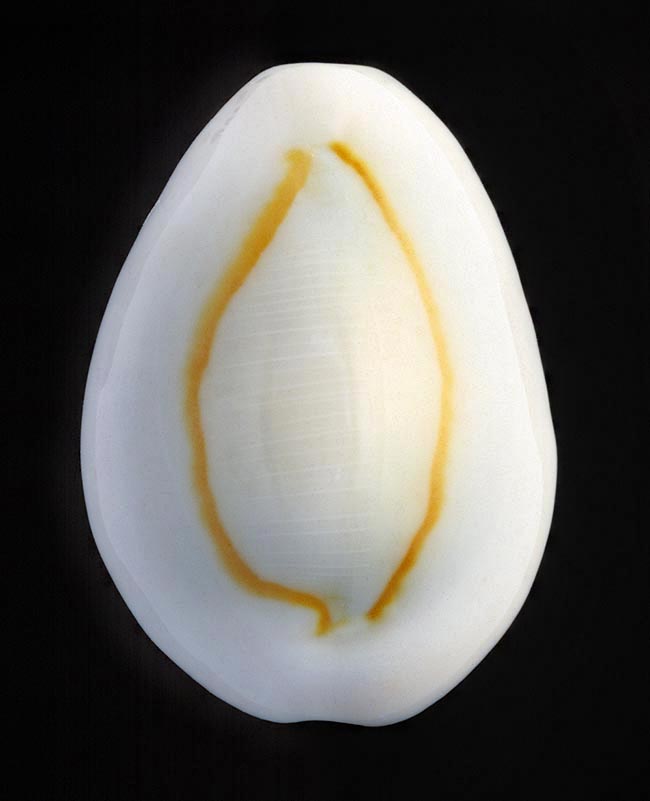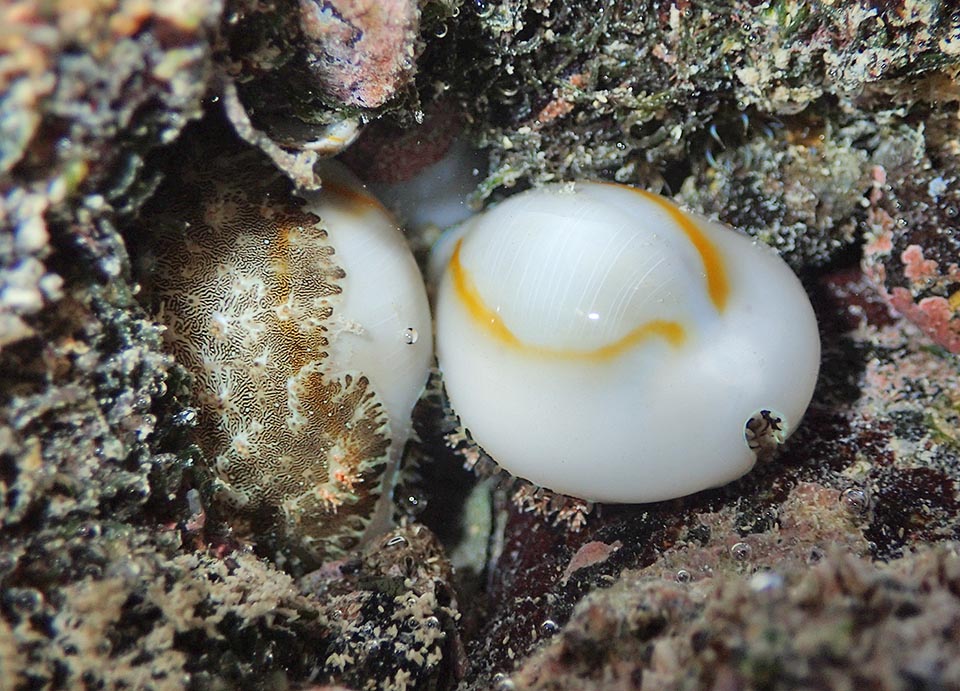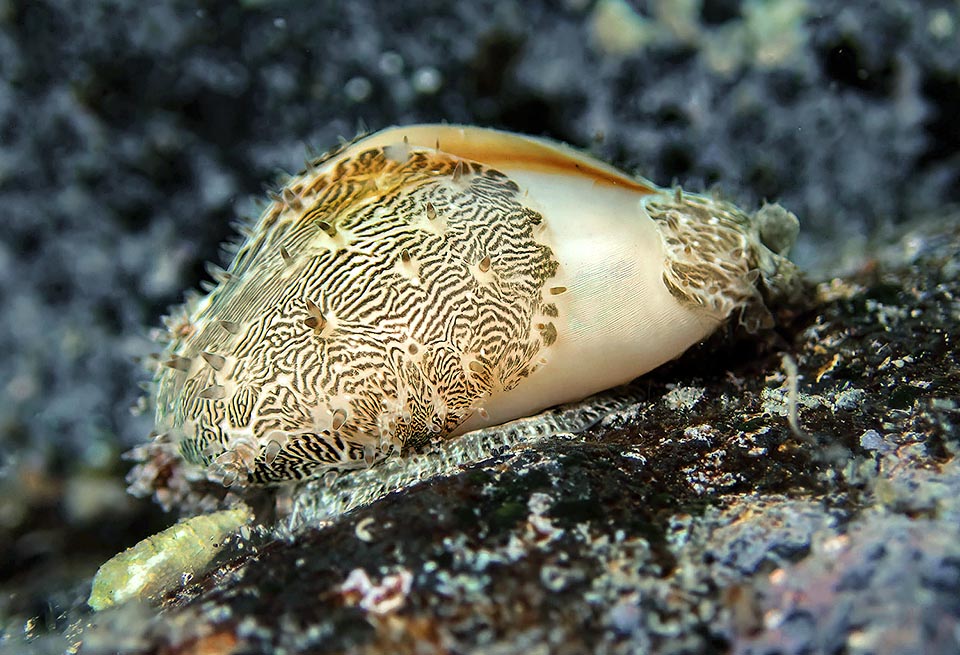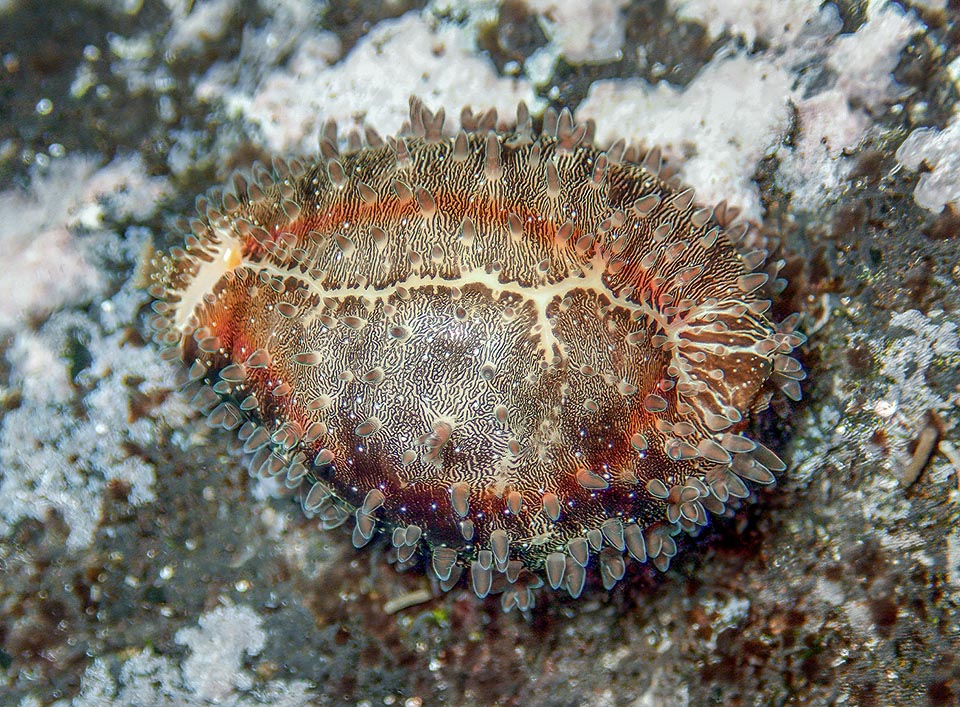Family : Cypraeidae

Text © Dr Domenico Pacifici

English translation by Mario Beltramini

Common in the Indo-Pacific, Monetaria annulus has been the first form of international coin in the man’s history © Giuseppe Mazza
Man’s history has always been characterized. by the research, caused by the growing and avid will of discovering the world surrounding him; by the ingenuity, active motor of a mind open to knowledge; but especially by the exchange of culture and of raw materials that has allowed contacts and connections between increasingly distant from each other populations.
The intensification of the trade routes led therefore to the necessity of attributing a value to the single goods traded, based on a criterion shared among the merchants.
And this is where at this point the real protagonist enters the scene: a small gastropod belonging to the family of the Cypraeidae.
Its name is Monetaria annulus Linnaeus, 1758, that, together with other similar species belonging to the same family, like the known Monetaria moneta Linnaeus, 1758, represent the cowry shells, considered the first form of international currency in human history.
It is thought that the first utilization of the cowries happened in China during the Neolithic whilst in the West it seems to have arrived only in the Middle Ages, thanks to testimonials on the collection of this mollusk in the Maldives.
As it is easy to guess, the name Monetaria annulus comes wholly from the Latin, where Monetaria gets its origin from “coin” whilst Monetaria means gold ring, due to its characteristic drawing distinguishing it from other cowries.
Zoogeography
Monetaria annulus is amply distributed in the Indo-Pacific region, with a strong presence in the African coasts and in those of Madagascar.
In the Pacific Ocean it has even reached the Hawaii Islands and the Galapagos. Present also in the Mediterranean where it has established itself as an alien species and in the Red Sea as an autochthonous species. Some gastropods have been even found in Japan but there is no official report yet about its distribution in this area.
In fact, it is thought that there are manifold subspecies of Monetaria annulus that render difficult its unambiguous classification.
Ecology-Habitat
The Cypraeids are nocturnal animals associated with coral reefs where they distribute depending on their diet, mainly formed by seaweeds and sponges.

Active by night, lives in the tidal zone from 1 to 8 m of depth. Retracting the coat, it shows on the shell the characteristic golden ring that has given the name to the species © Hans Hillewaert
Despite their fame, the knowledge about the main feeding and ecological habits of the cowries are very poor and the massive dispersion in different areas of the world has made impossible to define a single diet valid for all species.
Monetaria annulus lives in rather shallow waters (1-8 m) and more precisely in the zone of the littoral defined foreshore or intertidal, emerged in low tide conditions and submerged with the high tide.
The animals living in this environment must adapt to abrupt changes in temperature and salinity, developing and evolving systems that prevent their desiccation during the warmest hours.
It is not uncommon, in fact, to find this gastropod under stones, sand, weeds, and in tide pools that create during the day, whilst during the night it goes grazing the weeds with its spiny tongue, called radula, specialized in rasping rough surfaces.
Morphophysiology
The shell appears of oval size, smooth, glossy of cream colour, and can reach a maximum length of 4 cm in an adult specimen.

Associated to the coral reef, it mainly eats seaweeds and sponges, reaching in the adults the maximum length of 4 cm © Jean-Marie Gradot
These mollusks build their shells starting from a spiral shape covering it with a calcareous callus during the juvenile phase. In the adult phase the shape gets ovoid and the opening of the shell contracts forming some toothed surfaces around it.
The shine of the shell did so that the term “porcelain”, with which were indicated these shells in the Middle Ages, went to define the ceramic material characterized by the same shine. Moreover, on the upper part it displays a ring of orange-gold colour that, as previously cited, grants the name to the species.
The mantle is black tending to dark green, with a zebra pattern quite like a fingerprint.
It can be extroflected to completely cover the shell and allow an effective camouflage with the surrounding environment. This characteristic is shared also with another family of mollusks called Ovulidae, with which they are often mistaken.
The head has a well-developed respiratory siphon formed by a membranous lamina folded on itself to form a tube that perfectly embeds in the hinge formed by the shell. The pumping action of the siphon guarantees to the gills in the form of a comb, called ctenidia, the input of water necessary to irrigate them, allowing the oxygen to be absorbed.

It has a defensive mimetic mantle like fingerprints. The eggs, arranged one close to the other, in a circle, are protected by an adult until they hatch © Jean-Marie Gradot
Ethology-Reproductive Biology
Monetaria annulus seems to display two reproductive seasons: in spring and from late summer to winter. The individuals of this species, furthermore, have well distinct sexes with a marked sexual dimorphism, whereas the males are larger than the females.
The yellow ovigerous capsules are laid on the substratum one close to the other to form a circle that will be protected by an adult until the eggs hatch. The embryos develop in planktonic larvae and later in veligers, a larval form typical to the mollusks characterized by ciliate lobes forming the so-called velum, of crucial importance for the locomotion and for the nutrition.
Although the use of this mollusk for commercial purposes has been enormous over the centuries, at present the Monetaria annulus does not enter the list of the endangered species.
Synonyms
Ornamentaria annulus Linnaeus, 1758; Cypraea annulus Linnaeus, 1758; Erosaria annulus Linnaeus, 1758; Cypraea annularis Perry, 1811; Cypraea annulus camelorum Rochebrune, 1884; Monetaria camelorum Rochebrune, 1884; Monetaria harmandiana Rochebrune, 1884.
→ To appreciate the biodiversity within the MOLLUSCS please click here.
